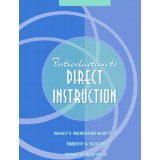 A friend sent me this uplifting story about one of her students who is learning to read. She introduced TAGteach in a recent session and her student’s performance soared.
A friend sent me this uplifting story about one of her students who is learning to read. She introduced TAGteach in a recent session and her student’s performance soared.
A tired student
“I have been working with a young girl with intellectual disabilities and speech challenges. She is learning to read with the well-known Direct Instruction Corrective Reading Decoding program. Dani (not her real name) came in this week looking tired and dispirited, and struggled with the first few words in the Word Attack practice section.
Using TAGteach for reading practice
This time, instead of cajoling her, I pulled out a tagger and started reinforcing correct and timely responses. For example, we worked on the word “each.” She had to say the sound of the underlined letter combination “ch,” then read the entire word, “each.” After asking her the first question, “what sound?” I sat back and waited for her response. She did not respond so I turned my head slightly away and gazed at a wall. After a pause, I heard a soft “ch” sound. This earned Dani a prompt tag. I asked “what word” and she responded fairly rapidly with “each.”
 So it continued. She earned tags for prompt responses (within 5 seconds of the request), and after working through two or three rows of words, she was responding on cue. I glanced at her and noticed that she was also responding with a stronger tone of voice AND had a smile on her face! We ended up having a terrific reading session. She completed Word Attack in record time with no errors. Her oral reading fluency for the text passage shot up by 23 words per minute from the previous session.
So it continued. She earned tags for prompt responses (within 5 seconds of the request), and after working through two or three rows of words, she was responding on cue. I glanced at her and noticed that she was also responding with a stronger tone of voice AND had a smile on her face! We ended up having a terrific reading session. She completed Word Attack in record time with no errors. Her oral reading fluency for the text passage shot up by 23 words per minute from the previous session.
Lots of tags = high rate of reinforcement … and joy!
She earned 124 tags in 50 minutes. This translates into 2.5 experiences of positive reinforcement per minute! In real time, she was being reinforced about every 25 seconds, so that is a very high rate of reinforcement. With her 124 tags she earned 12 tokens (10 tags per token) which she happily exchanged for prizes from our Reward Bin. Way to go, TAGteach!”
TAGteach: Good for academic skills as well as functional behaviors
This remarkable story shows how tagging Dani’s responses transformed this reading session into a successful, joyful learning experience. Many people are aware that TAGteach is a proven way to increase functional behaviors. It is also a marvelous way to increase academic behaviors.
What is TAGteach?
TAGteach stands for Teaching with Acoustical Guidance. TAGteach is a teaching and communication method based on the scientific principles of Applied Behavior Analysis (ABA).
TAGteach enables extremely precise positive reinforcement of behavior by using an acoustical signal to “mark” the behavior – at the precise moment the child performs the behavior! The acoustical signal is a short, sharp sound made by a handheld device (the “tagger”). When the child performs the correct action, the parent/instructor immediately presses the button on the tagger and hands over a treat (candy, treat, token, praise, social recognition, or money) as a reinforcer.
With TAGteach, it is easy to reinforce behaviors precisely and quickly. The immediate, accurate feedback and positive reinforcement result in the child performing the correct action more often, and for longer periods of time. With immediate feedback and learning tasks broken down into small steps, children can learn many new skills with TAGteach — at their own pace.
 Check out the TAGteach International website.
Check out the TAGteach International website.
Join the free TAGteach listserve.
TAGteach taggers are available here.
See Martha’s book about TAGteach for Autism or ask a question (with no obligation).
Sign up for my mailing list to receive updates, new articles and free tips right in your inbox!
If you liked this post, please share it on social media via the vertical gray menu on the far right. Thank you!
Share the post "TAGteach Tale: Turning reading stress into reading success with TAGteach!"
 TAGteach and Spelling
TAGteach and Spelling


 Check out the TAGteach International
Check out the TAGteach International 

